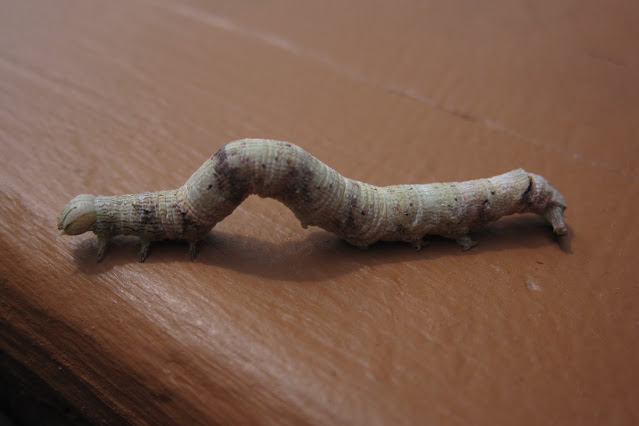It's the time of year when things are pretty quiet around the lakes. Most of the animals are done with searching for and attracting mates and are now carefully raising their young, doing their best to keep them hidden from predators. Food is plentiful so animals don't need to prowl widely in search of sustenance and so are able to keep to remote areas away from human activity. Hot, humid days also keep many animals deep in the forest with most of their activity taking place in early morning, late evening, or after dark when it's cooler, though I do see a doe and her fawn on occasion in the hour after sunrise. And I know other animals are out there because I find evidence of their travels and successful hunting trips dotting the trails.
 |
| Fox scat strategically deposited upon a stone wall. |
Yet there's still lots of activity to be found if one sets their sights on smaller, less visible life forms. This large American toad was squatting at the edge of a trail where there must be a plentiful supply of food.
a.JPG) |
| A fat American Toad waits patiently for a spider or slug to amble by. |
Spiders are abundant now and some are large enough to be a hearty meal.
 |
| A good size dock spider. |
While I was watching this spider I witnessed it catch a meal. It suddenly sprang off the rock onto the surface of the water and just as quickly leaped right back up on the rock. In one flash of continuous motion it had picked off some tiny insect. Spiders are close to the bottom of the food chain, consuming very small life forms, and in turn are eaten by toads, frogs, and snakes, which then are gobbled up by herons and various other birds and mammals.
 |
| A great blue heron watching for the motion of a frog, toad, or fish. |
I also saw this young painted turtle soaking in the warmth of the afternoon sun.It's shell was only about 3 inches long.
I may not see much activity in the forest in late August but it is a time when I start to notice changes in the trees themselves. It's very subtle, yet the differences are noticeable in the colors around the lake. The green on the trees seems just a little darker as photosynthesis and chlorophyll move into the latter stages of the season. Likewise the blue in the sky and and contrast of cumulus clouds in the mid day sun have a discernable change as the sun impinges at a slightly lower level. The days are now two hours shorter than they were back on the solstice and the sun sets across the lake noticeably farther south on Sheep Island. I do my best to ignore the stray branch on a red maple tree that has turned red and the poplar across the lake that show tinges of yellow - I tell myself those are weak or sick trees and not really a sign of a waning summer.
There are other signs that are harder to ignore. This week I heard the first pin ball game being played by the red squirrels as they gnawed cones off the top of the white pines which bounce off the branches as they fall to earth with a thunk that says "game over". Most of these seeds won't get to become mighty pines as they'll be collected and squirreled away in the harvester's winter stores. Someone passed on their observation that there aren't a lot of white pine cones in the trees this year, and I agree. In contrast, the spruce trees do seem to be over achievers this year.
 |
| Laden with cones on the east shore of Mark Island, I think this is a Red Spruce. |
Our little loon chick isn't quite so little any more, and in fact is now molting the last of her baby feathers and starting to reveal juvenile plumage, as captured by Debby Crowley this week.
 |
| At six weeks Maddie is starting to lose her downy baby feathers. Photos by Debby Crowely. |
 |
| Mom or dad brings in a big one. |
If she keeps eating like that there's no doubt she'll be ready for autumn when it arrives.



























